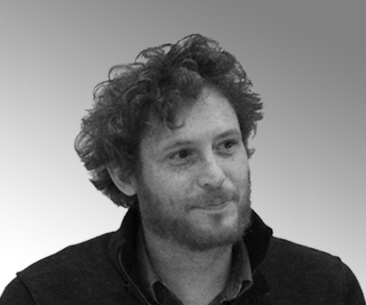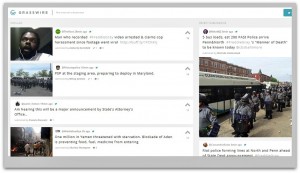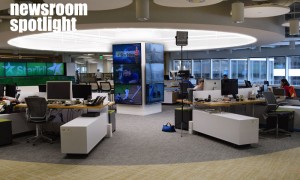
Editor’s Note: This Q&A is part of a Newsroom Spotlight, a series of conversations with journalists about what’s going on in their newsrooms and the media industry. The interview excerpts have been lightly edited and organized for clarity; it has been updated to clarify aspects of Digiday’s 20 events programs.

Brian Braiker/Courtesy of Digiday
In writing or working for The Guardian, Rolling Stone, ABC News, Newsweek and Adweek, Brian Braiker has experienced the waves of change shaking the media industry, making him a good fit for his role of executive editor at Digiday.
It’s a publication that “covers digital publishing, media, marketing [and] advertising,” Braiker explained.
He knows where journalism has been and has a sense of where it is going (all mobile, he says), which is why Digiday has recently implemented its “too long, didn’t read” option, as a nod to mobile audience. On longer articles, readers can hit the TLDR button for a shorter version of the story.
“It’s a more snackable version of Digiday essentially…all with mobile in mind, of course,” Braiker said.
He also has high hopes for the future of journalism. Asked to rate it on a scale of 1-5, Braiker gave the future “A 5! Always a 5! A 7.5!”
AJR talked to Braiker to find out about the inner workings of Digiday and get his views on the industry.
American Journalism Review: To start, how many employees and reporters does Digiday have?
Brian Braiker: Well, the whole company is growing. I would say 35-40 people. That includes editorial staff, sales, our content studio, our events staff and operations. On the editorial side, I think right now we’re about 10.
AJR: On a daily basis how much news are they producing?
Braiker: It depends on what you mean by news. We’re not necessarily in the business of reporting the news. What we provide is a reported analysis. There are other websites that will report breaking news or new hires or new product releases or whatever. We provide an informed take on what that means and why that is relevant – sort of bigger picture stuff.
Our reporters are basically each expected to write one [story] a day. Not everyone on the editorial staff is producing one a day. I think average is … five to seven stories a day [usually 500 to 700 words]. For a lean staff, that is a pretty good output. It is important to know that all of that is original reported stuff. We don’t do any aggregation.
AJR: When your writers are doing things like that, how quick is a turnaround for a story?
Braiker: Our turnaround period is basically a day. We get in, the day starts at 9:30. We have an editorial meeting at 10 a.m.. Everyone talks about what they’re doing and if they don’t have a good idea, we brainstorm to assign a story to them. On Mondays we have a longer meeting; it sort of talks about what we’re working on for the week and a bigger, broader look at what we’re doing for the next several days.
We also do these long reads. We don’t like the expression of “long reads,” we call them “deep dives.” Those are reported over a couple of weeks. People are still expected to file their daily stories, but they’re reporting on stuff in the nooks and crannies of their day and then they take a day or two to assemble and write it. Those will be longer – about 1,000 to 2,000 words. They’ll take a much more nuanced look at a specific thing. We’re also doing a podcast a week. That’s been going on for a couple months now.
AJR: So this podcast, this is a new thing, you said?
Braiker: None of us are podcasters, so we’re sort of figuring this out.
AJR: So what do your podcasts cover? Do you take a story and make it for a podcast, or do a podcast that’s not something that you’re writing for the web?
Braiker: The podcast is usually born out of something that we’re covering. Either it’s a broad theme or a specific story. We’ve written, for example, a lot about the advertising agency Talent Crunch. So our brands-based team editor, Shareen Pathak, knew that the president at J. Walter Thompson, Lynn Power, would be a good person to talk to on that subject, so she came in, and we did a podcast with her. We talk a lot about ad tech – advertising technology – how that’s transforming publishing and the way brands advertise. So we talked to Terry Kawaja, who created this thing called the LUMAscape, named after his company, Luma Partners. He is sort of a pioneer in the field of advertising technology, so we have him on a podcast. So it’s usually thematic. Sometimes it’ll be a specific story, like publishers publishing directly on Facebook and whether that is a good move for publishers or not.
AJR: And who is doing these podcasts? Do your writers who wrote the story do them?
Braiker: It’s a rotating job. The reporters do it, and the host rotates. Brian Morrissey, our editor in chief, has done a bunch. I’ve hosted one. It’s very much a live experiment what you’re hearing on the podcast, but so far, so good.
AJR: Have you had any reactions from listeners ?
Braiker: Oh yes, it’s been enthusiastic. Podcast is really a small fraction of what we do; I wouldn’t overemphasize it. We did pass PoultryCast podcast for the news and information or business podcast on the rankings, so we were very happy to beat out PoultryCast [laughs]. But creating a podcast is not our main business. It’s something that we’re doing with minimal resources in the corners of our day, and I think it’s worked out well for us as a brand, but we’re still figuring out how it works. I think that the way the podcast works is to loosely model it on a sort of “Fresh Air” Terry Gross model, where you just [have] as high profile a person as possible, and a wide range of conversation. It looks like they work better when the person you’re talking to – their name – has some traction in whatever industry it is. We’re tinkering with the model.
AJR: How do you and your staff go about doing multimedia, from videos to photos?
Braiker: It depends. We don’t do a ton of original video or photos. (Our) assistant reporter Tanya Dua is a recent Columbia grad, and she is pretty good at shooting and editing video, so the little original video we’ve done, she’s shot. Sometimes we’ll do agency tours – literally tours of advertising agency offices – and we’ll take pictures with an iPhone. A reporter will do that. As far as day-to-day art, unfortunately we’re probably too dependent on stock photos, but we try to be creative with them. We have an in-house design team, but share them with the marketing department so when we can, we ask them to customize art. I really don’t think any of us particularly enjoy the stock photo aesthetics, we try to put as much of our sensibility into the art as we can. In terms of multimedia, wherever possible we’ll embed a tweet, an Instagram photo, Vine, especially if it’s illustrative of some sort of point we’re trying to make.
AJR: How are you tailoring things for readers that get your stories and your information from a mobile device?
Braiker: We’ve been responsive design from the very beginning. We’ve always kept the mobile reader in mind first and foremost. We’re tinkering with a new article page layout,…an alternate version of the story that’s sort of a boiled-down version of the story that’s very much geared with the mobile reader. If you follow us on Instagram you will be seeing some of those stories. They’re not meant to be teasers to the story; they’re meant to be sort of the main takeaway / cocktail conversation point. We’ve done that a little bit on Facebook, too. Again this is something that we’re very much experimenting with at the moment. So, yeah, we are fully geared up for the mobile reader.
AJR: How does the newsroom use analytics to make coverage decisions? How do you go about figuring out what is going to be the most popular? Do you go by what’s going to get the most clicks or shares?
Braiker: No, I don’t think we make editorial decisions based on what is going to be the most popular. We tell the story that we want to tell. Sometimes analytics will help us inform how we promote the story on social. Analytics will help us maybe tweak a headline, but I don’t think it will help us determine our coverage. We determine our coverage. For example, if we see a story is doing well on Facebook, we’re not adverse to boosting it because we’ve found that once that graph starts going up, if you give a little boost on Facebook it really skyrockets. Same thing on Twitter. For example, if a quote from a story is really resonating on Twitter, maybe we’ll tweak the headline to incorporate the quote or promote a tweet that has that in it. I think analytics are great, but I don’t think it’s wise to be a slave to analytics in terms of deciding what to cover.
AJR: Does Digiday use any user-generated content? Or plan to?
Braiker: No. It’s not really something that we’re for. We do occasionally run contributed pieces from very informed or plugged in [sources,] or some of the people we have at our summits, industry leaders. We’ll also reject contributed pieces from people if we don’t think they fit in with our voice, but we’re not a user-generated site. … I think we’ll do stories where we’ll crowd-source information.
AJR: You mentioned social media. Are all of your reporters required to use their own personal accounts?
Braiker: At this point we assume that anyone who is going to write for us has already got a social media presence. I wouldn’t say necessarily that they’re required to tweet every story; I think that they do and they probably should. But you can’t force it. Some reporters really get Instagram, and some don’t. Some reporters really have a Twitter sensibility, and some don’t, and you can’t force it. You have to play to your team’s strengths or let your team play to their strengths. … There’s no one on our staff who doesn’t have a Twitter account. As far as Digiday editorial Twitter presence, every reporter basically has a day where they’re in charge of the Digiday Twitter account, so we rotate that. Generally we’ve managed to keep a consistent voice. The Digiday Twitter account is not really about interacting so much as it is about getting our stories out there. The reporters’ accounts are more interacting, and that’s fine. The Digiday account will retweet individual Digiday reporters and their stories. The Digiday Twitter account does not get very cute, but reporters are encouraged to get as cute as they want with it.
AJR: And what about your Instagram account?
Braiker: We all have the sign on, but I think the … it depends on if there’s an event. We had a publishing awards event and we assigned Instagram to a reporter that night who didn’t have any other specific duties. Instagram is a little more hodgepodge right now – that’s something we’re still trying to figure out, but it’s doing well. Part of what we do, the company puts on these events that the reporters and editors are in attendance, and they are sort of an editorial product. They are either part of the editorial product, [or] they feed into the editorial product.
AJR: So what kind of events does the company put on?
Braiker: To back up a little bit to explain the Digiday mission. We cover publishing – and by publishing I mean news media and entertainment and media. Publishing brands, advertisers, marketers and retailers are making this historic transition from analog to digital, right? From A to B, and everyone’s at a different point on the continuum. You’ve got people like The Atlantic, a 126-year-old media company that is redefining themselves as digital juggernauts; and then you’ve got people like BuzzFeed, who are digital natives. So we’re covering where these grand publishers and agencies are on this digital transition, and it is a historic transition, and it keeps changing. One day it’s mobile first, and the next day it’s …
So we’re covering this gigantic shift into the digital era for publishers. For our events, we gather the key players in each of these arenas and have these events. For example, at [one of our] publishing summit, we [featured] Huffpost, Al-Jazeera, Playboy, BuzzFeed talking about trends in modernization, whether it’s native advertising or how you publish on Facebook. Publishing summits are our biggest. We also do them for brands. Big brands like GE have come as well as smaller brands like Beta Brand that’s doing a lot of innovative stuff in digital, and talk about what they’re doing. Then we’ve started doing retail summits and smaller events as well. Also, we opened up our European editorial offices last year and we’re expanding deeper into Europe with our events as well. Basically the luminaries in their industry talking about where things are going in a no-bull atmosphere. Just the cream of the crop talking about what they’re thinking about.






